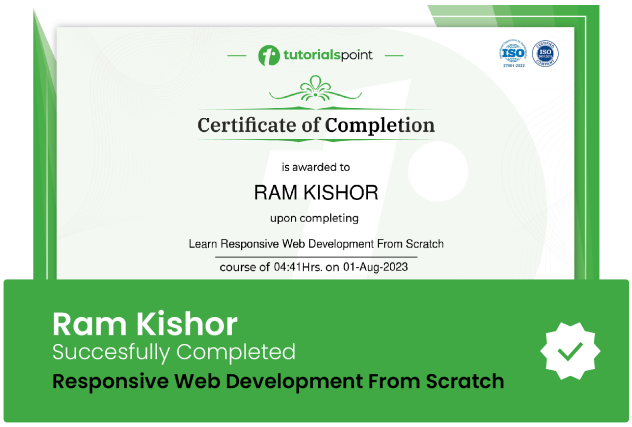Introduction to Electronic Components: A Step By Step Guide
This course will give you everything you need to start playing with electronics components and fix electronic devices

Lectures -34
Duration -3 hours

30-days Money-Back Guarantee
Get your team access to 10000+ top Tutorials Point courses anytime, anywhere.
Course Description
Welcome to this course.
Topics that we will be discussed during the Introduction to Electronic Components Course are listed here in a brief outline.
The Components of Electricity
Volt-Ohm-Meter Basics (Measuring Electricity)
Circuit Diagrams Basics (Electronic Roadmaps)
The Resistor
Ohm’s Law
The Capacitor
The Inductor
The Diode
The Transistor (Electronic Valves)
Things You Should Know before we start
The topics up to and including Ohm’s Law are what we will start with.
The remaining topics cover additional fundamental components of basic electronics.
The course will be in platform discussion, guide practices, and open question format as the material dictates.
The course uses a standardized volt-ohm-meter (VOM) for illustration.
Quick Summary of things that we will discuss through this course
In this Introduction to Electronic Components Course, We will begin by discussing the three components that make up electricity.
Next will spend more extensive time on how to measure the three components of electricity. During this section, we will explore two of the three components (voltage and current).
This section will cover VOM basics and allow you to become familiar with the most important and most basic piece of test equipment.
At the next section, Circuit diagrams section, you will learn how to use electronic components symbols on an electronic road map called a schematic or circuit diagram.
Many of the symbols will represent new concepts for many of you and these concepts will be fully developed once we finish the section.
As a result, you will develop the fundamentals of interpreting circuit diagrams so that these illustrations of the arrangement of electronic components can help you with the remainder of the course.
The final of the three components, resistors will be covered next.
How the three component are related mathematically is Ohm’s Law and this fundamental law will be covered in detail. These sections make up the basic, basic material of electronics.
Four additional components common to virtually all electronic circuits are the capacitor, inductor, diode, and transistor. I will cover these topics with a level of detail that will familiarize the audience with the function of these components and the basics of how they work and react in different situations.
There are text reading assignments for each section of the course.
Who this course is for:
- Anyone with a need to brush up their knowledge of basic electronics
Goals
What will you learn in this course:
- Understand the concepts of voltage, resistance and current
- Understand the VOLT OHM Meter/ Digital Multi Meter and how to use safely
- Use Ohm's Law to calculate voltage, current and resistance
- Use resistors in various configurations
- Understand and use capacitors
- Understand and use diodes
- Understand and use a transistor
Prerequisites
What are the prerequisites for this course?
- A multimeter
- A breadboard, jumper wires and a battery
- Resistors, capacitors, LEDs, diodes, transistors, voltage regulators

Curriculum
Check out the detailed breakdown of what’s inside the course
Introduction
2 Lectures
-
Introduction 04:34 04:34
-
Who We Are? 05:26 05:26
Basics
3 Lectures

Introduction to DMM
1 Lectures

Voltage: Taking Measurements
3 Lectures

Current: Taking Measurements
4 Lectures

Resistance: Taking Measurements
2 Lectures

Circuit Diagram Basics
1 Lectures

Resistors
2 Lectures

Ohm's Law
1 Lectures

Capacitors
4 Lectures

Inductors
2 Lectures

Diodes
3 Lectures

Transistors
4 Lectures

The End
1 Lectures

Instructor Details

Ashraf Said
eCourse Certificate
Use your certificate to make a career change or to advance in your current career.

Our students work
with the Best


































Related Video Courses
View MoreAnnual Membership
Become a valued member of Tutorials Point and enjoy unlimited access to our vast library of top-rated Video Courses
Subscribe now
Online Certifications
Master prominent technologies at full length and become a valued certified professional.
Explore Now


 Updated on Apr, 2024
Updated on Apr, 2024
 Language - English
Language - English